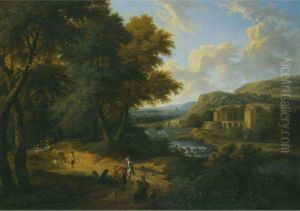Pieter Bout Brussels Paintings
Pieter Bout was a Flemish painter born in Brussels in 1658. He is renowned for his landscapes, cityscapes, and maritime scenes, which exemplify the vigorous and detailed approach characteristic of Flemish art in the late 17th and early 18th centuries. His work often incorporated lively human figures and detailed depictions of nature, showcasing his skill in capturing the essence of his subjects with precision and a keen eye for detail. Despite the prominence of landscape painting in his oeuvre, Bout also explored other genres, contributing to his versatility as an artist.
Bout's artistic journey was significantly influenced by his time in Paris, where he moved early in his career. There, he collaborated with the French painter Adriaen Frans Boudewijns, who had a profound impact on his style and thematic choices. Their partnership was fruitful, leading to several joint works that combined Bout's detailed figures with Boudewijns' landscapes, exemplifying a harmonious blend of their talents. This period was crucial for Bout, as it allowed him to refine his technique and establish his reputation in the art world.
Throughout his career, Pieter Bout was active in several European cities, which enriched his artistic language and exposed him to a variety of influences. Despite the mobility of his career, he maintained strong ties to his Flemish roots, which remained evident in his work. His paintings are characterized by their vibrant color palette, dynamic compositions, and the ability to convey atmospheric effects, making them highly sought after by collectors and art lovers alike.
Pieter Bout's contributions to the Flemish art tradition were significant, and his works continue to be celebrated for their technical skill and aesthetic beauty. He passed away in 1719, leaving behind a legacy that has kept his name alive in the annals of art history. His paintings are preserved in various museums and collections worldwide, serving as a testament to his enduring appeal and the timeless quality of his art.


